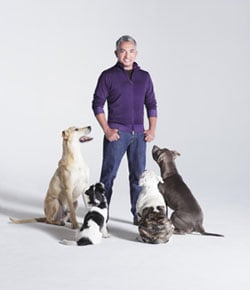Last night I attended the Rochester, NY appearance of America’s most famous dog trainer, Cesar Millan, in town for his “The Pack Leader” tour.
In the interest of full disclosure, until that point my exposure to Millan was limited. I’d never seen his show, never seen him train a dog or talk about training a dog, never read his book (although I do have a copy of “Cesar’s Way”, picked up at the used bookstore, in my to-read pile).
I had seen him profiled on CBS Sunday Morning and found him charming and interesting, and was impressed that he had about 30 dogs off leash while I was at my wit’s end with three warring dogs and a cat. Woof!
So when people talked about what a horrible, inhumane trainer Cesar Millan is, I really didn’t have an opinion about him one way or the other. As a Christian, I’ve been on the receiving end of the judgmental finger pointing so I try to avoid doing that to others. I’d heard comments that ranged from “He’s rude” to “Let’s get the shotguns”. Honestly, I can’t form an opinion based on that. I needed to see for myself.
And after watching Millan’s performance last night, I now have an opinion.
The show opened when Cesar Millan stepped onstage wearing a giant puffy parka, earring sparkling in the house lights. The crowd cheered. I mean, literally cheered. In the dog world, Millan is apparently a rock star. He smiled, waved, took off the coat, and got down to business.
The first half of the show was hilarious. I mean, laugh out loud hysterically funny. Whether Cesar Millan was imitating a yapping Pomeranian or lying on the floor demonstrating a cat giving itself a bath, he had the crowd laughing. He’s a natural storyteller, and has an uncanny way of demonstrating animal behavior, pointing out mistakes humans make while making us laugh at the same time.
He made jokes about his immigration status – he came here illegally but is now a citizen. I thought some of it was in poor taste – he joked that Mexicans trying to cross the border invented the first agility courses. But he was open and honest (qualities he stresses in training) and he was thoroughly entertaining.
He also made a lot of great points, talking about a dog owner’s need to be a stable leader, to be calm, to meet the dog’s needs of body, mind and heart, to understand how our own behavior can lead to anxiety and instability. He said, “Dogs in other countries are skinny but they don’t have psychological problems. Dogs in modern countries are chunky and they have psychological problems,” that our dogs have everything but are experiencing instability.
In other words: we Americans humanize our dogs too much. Amen.
He talked about problems like fear and anxiety and aggression being the outcome of problems rather than the problems themselves, and how addressing the root problems in body, mind and heart would be the path to the solutions. He mentioned that there are different techniques to achieve those solutions, but he didn’t go into detail.
Unfortunately, technique is the problem that many have with Millan. I think most trainers – even positive trainers – could agree with much of what he said in the first part of the show. But what he glossed over is exactly where the problems lie. And after intermission, I got to see it for myself.
Keep in mind that I’ve never seen “The Dog Whisperer,” so what Millan shared last night I can only assume was what he considered his best work, and what is most indicative of his methods and technique.

He opened the second half of the show with a clip of South Park that parodied his show,” The Dog Whisperer.” I have a friend who talks all the time about how much she hates when Millan “tssts”. I didn’t understand what she meant; I mean, I click my tongue to the dogs all the time. Watching the parody, I finally got what she meant.
What I didn’t understand was why people were laughing? I mean, it was a complete mockery of Millan, pointing out how his method of training was insensitive, mean, rude, and well, really rude. But the crowd laughed and clapped, as if pinching and intimidating are funny and acceptable.
Sorry, but it’s all rude in my book.
Then Millan brought out a dog he’d been working with; the dog was led by Millan’s assistant Allegra, whom Millan said had never had a dog. The dog walked on the leash ahead of Allegra, sniffed, seemed comfortable. And then Millan took the lead and the dog froze. Obediently, yes, but it was frozen obedience.
Millan then switched the dog’s lead, from a very thick lead to a wire-thin lead, which he held taut, high up on the dog’s neck. The dog was calm, and at times lay down and was fine on and off leash. But when the lead was in Millan’s hand, it was taut the whole time and the dog seemed on alert. We were in the balcony and I was specifically watching to see how often the lead was slack; not often.
Which made me wonder: why was the dog obeying? Clearly this dog had worked for a long time with Millan and knew the ropes. You don’t bring a strange dog out onto a stage with thousands of people making noise; you bring out the dog you know is going to do exactly what you want. But the dog, while calm, certainly never seemed happy – if I can be allowed to analyze canine emotion for a moment. I didn’t see any relaxed mouth, for example, what most people would call a smile. I didn’t see tail wagging. I saw a dog waiting attentively and quietly. And yes, calmly.
But there’s one thing I’ve learned about dogs – and people, for that matter: just because they do what you want, it doesn’t mean they like you.
Then Millan shared a video clip from an episode of his show where he hooked up a dog and owner to heart monitors to see how their heart rates affected the dog’s behavior. As expected, when the owner’s heart race increased, so did the dogs. And a calm Millan meant a calm dog. The crowd cheered.
His point was excellent: a calm owner leads to a calm dog.
Except … if I can be forgiven for pointing out the obvious … that was TV, where a 3 minute clip may take 10 hours to film, and filmed over and over again from different angles. Who knows how much time passed between the owner and dog experiment, and the Millan and dog experiment? Or how many tries it took? What you see on TV is not real, people. It’s manufactured reality. It takes a long time – a loooooong time – to train a dog, and even longer to train the owner. What we saw in the clip was success, but what was missing was the process. And I think it gives a false impression of what it really means to train a dog.
Another thing that raised a red flag: the dog in the video was on a choke chain. Millan said that it wasn’t his decision to put it on the choke chain, that it was the owner’s and that he uses whatever method the owner is comfortable with. I thought that was a cop out and an attempt to placate the positive, force-free trainers in the audience. If he truly believed that using a choke chain was forceful, methinks he would be offering to owners a better, more humane method. (There were some trainers: before the show, a small group stood in front of the venue handing out a flyer with a list of local positive dog trainers and information about dominance-based training.)
By now the hairs on the back of my neck were prickling – not because of things people had told me about Cesar Millan, but because of what I was watching with my own eyes and hearing with my own ears. Talk about dominance and pack mentality – knowing that research has proven that: 1) dogs are not wolves any more than men are apes and 2) what we thought we knew about wolf packs has been completely invalidated once we began to study wolves in the wild. (That was the basis for a piece I wrote yesterday.)
The dog sleeping at your feet is not now, nor has he ever been, an animal that has lived in the wild, lived in a dog pack, or experienced any desire to dominate you. He’s a dog, and he understands one thing: you feed me, I stick around. (One expert I read called it a parasitic relationship, and while that’s a harsh term … it’s pretty accurate when you think about it.) You do not need to grab your dog by the scruff the way a mother dog would because, and forgive me for stating what should be obvious, you are not a dog nor are you your dog’s mother. Your dog has not now nor has he ever looked at you like his dog mother and grabbing his scruff means only one thing: Ouch! This stupid human is hurting me!
But I digress.
Of even more concern last night: the reaction from the audience. I’m a firm believer that I should follow a principle or philosophy or moral compass, not a person. And none of it blindly. But I’ve venture a guess that the majority of dog owners in America are looking for a quick fix. Do A, yank B, pinch C and viola! You’ve gotten your dog to do what you want.
But as I told a commenter who chided me yesterday about dogs needing leadership and someone to be in charge: there’s a difference between being a leader and being in charge. People who are in charge are not necessarily leading and not every leader is the one with the brass plate on the desk that says “boss.”
And intimidating dogs into doing what you want by pinching them or leashing them in their most sensitive place is neither leading or being in charge. It’s being rude and being a bully.
And if I can digress for a moment, one thing I’ve noticed is that people who love Cesar Millan tend to be people for whom obedience is more important than relationship in other aspects of their lives, as well. At work, at home, with their kids, with neighbors, politically, religiously. Someone I love dearly but who has always been extremely strict, emotionally cold, and rigidly egocentric, once said to me, “You know, Cesar Millan would have that dog fixed in 5 minutes.” My dog didn’t need to be “fixed”, and whatever behavior needed to be worked on took more than 5 minutes. And I’m happy for it, because the process actually built a long, loving, strong emotional bond between human and dog – something I fear my friend may never have experienced.
The show ended with a Q&A session, and here is where I thought Millan let his guard down, and not to his credit. The questions were simple – what do I do about a dog who sneaks people food? what do I do about my dog who barks in the car, but it’s a happy bark? He asked Allegra to read the questions several times; the first one about the people food had him totally stumped, and he seemed to scramble for time and eventually fell back into some long winded recap about stability.
(For the record, my answer to the question about dogs who steal people food – the answer which I also got from Ada Simms, the trainer I talked to later: 1) Put the food away where the dog can’t get it – duh; 2) keep your dog out of the room where people meals are being eaten; 3) and teach your dog a strong “leave it” so that you can have your dog in the room with food without the fear of drive-by dog raids of your plate. I speak from experience, my friends.)
Even more so, by this point in the night, Millan seemed a wee bit irritated. He’d already snapped a couple of times at the video folks – at first it was good humor (“I’m legal now, I can fire people”) but eventually he was staring at them off stage, much the way I imagine he glares at bad dogs.
In the end, I can only say that I prefer to build a relationship with my dog where he wants to do the things I ask him to do, where he wants to be with me because being with me is the greatest thing he could think of to do. Not a dog who obeys because he knows he’ll get pinched or grabbed by the scruff or “nudged” in the kidneys, however gently.
Obedience is not a relationship. It is the outcome of a relationship. And if you find yourself cheering a man instead of his philosophy, perhaps you need to be doing some thinking. Not throw the baby out with the bathwater, by any means. Cesar Millan is a really great motivational speaker. He has some excellent points about how we humans fail our dogs. His goals for the most part are completely valid. He’s smart, likeable, funny and he really does love his dogs and have a connection with them.
But I think the paths he’s taking to achieve his goals need to be reevaluated in the light of current research, and for that, I must- forcefully – disagree with his methods.
Of course, for the American dog owner, reevaluating Millan’s methods might mean dog training that takes longer, requires more time and energy, and involve a much, much, much deeper emotional commitment than perhaps many are willing to give.
Because, in the end, the problem is not the dog but the dog owner. Something I think Millan and I might agree on.
RELATED POST:
- At BarkAroundTown.com, my Rochester dog blog: What’s wrong with Cesar Millan and dominance-based dog training?
- If dogs think and feel, do aversive training techniques cause harm?
* * * * * * * * * *
A P.S. FROM THE AUTHOR: 1/17/12:
To everyone who has soooo graciously taken time to comment on this article – whether you liked it, hated it, agreed with it, disagreed with it, or think I’m completely off my rocker: thank you for taking time out of your day to read the piece and share your thoughts.
For those who disagree, I do want to just reiterate: this is a review, which means it’s my thoughts and opinions about that evening’s event and how it influenced my opinion of the material presented. If you’re still not clear why a review did not require me to do 10 hours of research or watch 9 seasons of “The Dog Whisperer” to comment on what I saw that night, please send me an email and I’ll explain the definition of “review.”
To those of you offering kind words: Thank you for support and for taking time share your stories. I am smart enough to know how ignorant I really am and am happy to learn more, so I take the critical comments in that vein. But I also appreciate a brief pat on the back once in a while. Today, you were my cookies. Click. Treat. Woof!












